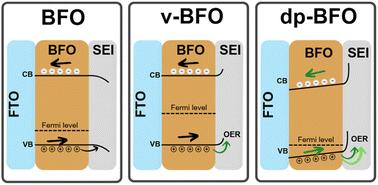利用铁电极化诱导p型铋铁氧体的n型光阳极行为
IF 9.5
2区 材料科学
Q1 CHEMISTRY, PHYSICAL
引用次数: 0
摘要
铋铁氧体(BFO)由于其在室温下的多铁性和适合太阳能收集的带隙特性,在光电化学(PEC)反应中具有广阔的应用前景。此外,尽管BFO是p型半导体,但内部电场可以诱导显著的阳极光电流,表明利用其可切换的极化能力对材料的p/n型行为进行调节。然而,偏振场如何控制BFO光电极的p/n型行为的机制仍然不清楚。在这里,我们报告了极化对表面化学、电荷动力学和最终的PEC性能的影响,以及这些影响如何使BFO从p型行为转变为n型行为。通常,在BFO中促使p-to-n型行为转换需要在高温下通过退火/真空处理引入氧空位,其中BFO中的大部分载流子被改变。相比之下,下极化BFO中诱导n型行为的起源是不同的,归因于负电荷表面,梯度能量调制和负移带能。利用BFO光电极的偏振态来切换n/p型行为的策略为在PEC系统中开发可调谐光电极提供了一种简便的方法。本文章由计算机程序翻译,如有差异,请以英文原文为准。

Inducing n-type photoanodic behavior in p-type bismuth ferrite via ferroelectric polarization
Bismuth ferrite (BFO) has shown great promise as a photoelectrode for photoelectrochemical (PEC) reactions arising from its multiferroic properties at room temperature and suitable band gap for solar harvesting. Further, despite being a p-type semiconductor, the internal electrical field in BFO can induce significant anodic photocurrent, indicating a regulation of the p/n-type behavior of the material by exploiting its switchable polarization capacity. However, the mechanism behind how the polarization field controls the p/n-type behavior of a BFO photoelectrode remains ambiguous. Here, we report on the effects of polarization on surface chemistry, charge dynamics and ultimately PEC performance, and how these effects enable BFO to switch from p-type to n-type behavior. Conventionally, prompting a p-to-n type behavioral switch in BFO requires the introduction of oxygen vacancies by annealing/vacuum treatment at an elevated temperature, where the majority charge carrier in BFO is changed. In contrast, the origin of induced n-type behavior in down-polarized BFO is different and is attributed to a negatively-charged surface, gradient energy modulation, and negatively shifted band energies. The strategy of exploiting the polarization states of BFO photoelectrodes to switch n/p-type behavior offers a facile approach for developing a tunable photoelectrode in PEC systems.
求助全文
通过发布文献求助,成功后即可免费获取论文全文。
去求助
来源期刊

Journal of Materials Chemistry A
CHEMISTRY, PHYSICAL-ENERGY & FUELS
CiteScore
19.50
自引率
5.00%
发文量
1892
审稿时长
1.5 months
期刊介绍:
The Journal of Materials Chemistry A, B & C covers a wide range of high-quality studies in the field of materials chemistry, with each section focusing on specific applications of the materials studied. Journal of Materials Chemistry A emphasizes applications in energy and sustainability, including topics such as artificial photosynthesis, batteries, and fuel cells. Journal of Materials Chemistry B focuses on applications in biology and medicine, while Journal of Materials Chemistry C covers applications in optical, magnetic, and electronic devices. Example topic areas within the scope of Journal of Materials Chemistry A include catalysis, green/sustainable materials, sensors, and water treatment, among others.
 求助内容:
求助内容: 应助结果提醒方式:
应助结果提醒方式:


